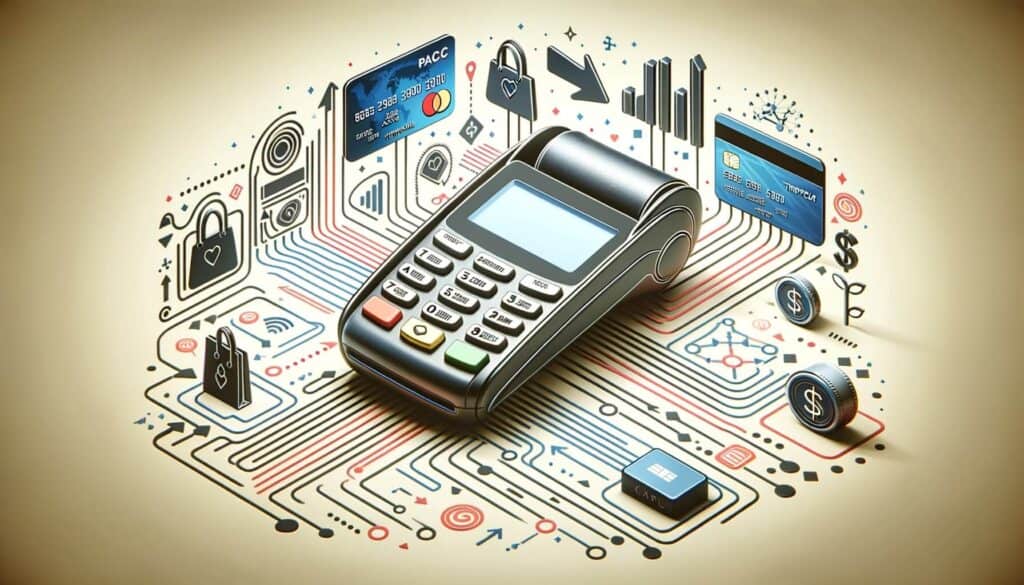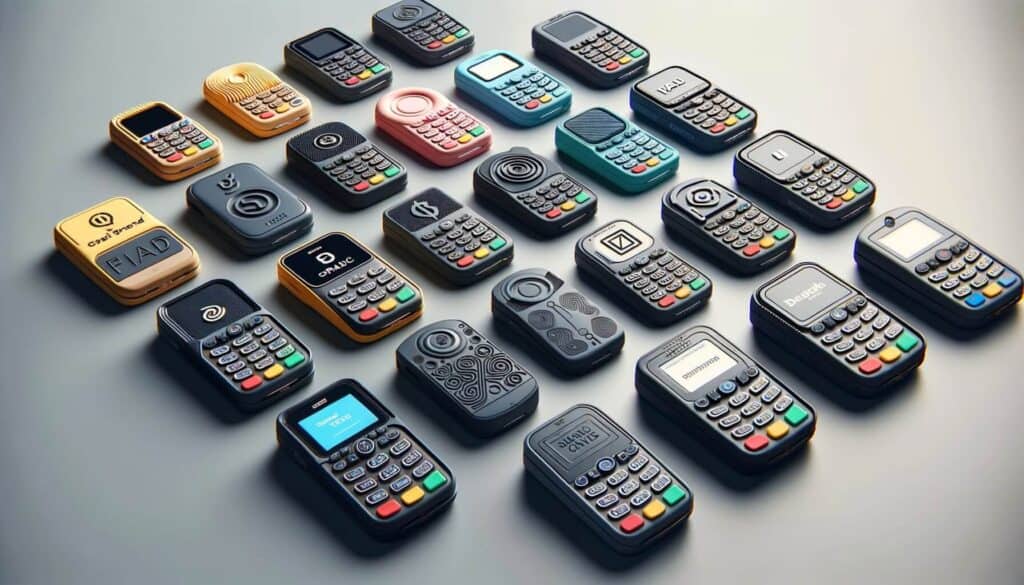
By Harriet Forster March 25, 2025
In today’s fast-paced and digital world, businesses need to adapt to the changing landscape of payment processing. Gone are the days when cash was king, as more and more consumers prefer the convenience and security of using credit cards for their purchases. To meet this demand, portable credit card terminals have emerged as a game-changer in the payment processing industry.
In this article, we will explore everything you need to know about portable credit card terminals, from how they work to the benefits they offer for businesses.
How Portable Credit Card Terminals Work: A Step-by-Step Guide

Portable credit card terminals are handheld devices that allow businesses to accept credit card payments on the go. These terminals utilize wireless technology, such as Bluetooth or Wi-Fi, to connect to a merchant account and process transactions securely. Here is a step-by-step guide on how portable credit card terminals work:
1. Merchant Account Setup: Before using a portable credit card terminal, businesses need to set up a merchant account with a payment processor or acquiring bank. This account enables the transfer of funds from the customer’s credit card to the business’s bank account.
2. Terminal Activation: Once the merchant account is set up, the portable credit card terminal needs to be activated. This typically involves entering the terminal’s serial number and connecting it to the merchant account.
3. Transaction Initiation: To process a payment, the merchant enters the transaction amount into the portable credit card terminal. The customer then inserts or swipes their credit card into the terminal, or in some cases, taps their contactless card or mobile device on the terminal.
4. Authorization and Verification: The portable credit card terminal securely transmits the transaction details to the payment processor or acquiring bank for authorization. The bank verifies the customer’s credit card details and checks for available funds.
5. Transaction Approval: If the customer’s credit card is approved, the payment processor or acquiring bank sends an authorization code to the portable credit card terminal. The terminal displays the approval message, and the customer can choose to receive a printed or digital receipt.
6. Settlement and Funds Transfer: At the end of the day or a specified settlement period, the payment processor or acquiring bank transfers the funds from the customer’s credit card to the business’s bank account, minus any applicable fees.
Benefits of Using Portable Credit Card Terminals for Businesses

Portable credit card terminals offer numerous benefits for businesses, making them an essential tool in today’s payment processing landscape. Here are some of the key advantages of using portable credit card terminals:
1. Increased Sales Opportunities: By accepting credit card payments, businesses can cater to a wider customer base. Many consumers prefer using credit cards for their purchases due to the convenience and security they offer.
2. Improved Cash Flow: With portable credit card terminals, businesses can receive payments instantly, eliminating the need to wait for checks to clear or for customers to pay in cash. This improves cash flow and allows businesses to access funds more quickly.
3. Enhanced Customer Experience: Portable credit card terminals enable businesses to provide a seamless and convenient payment experience for their customers. Customers can pay with their preferred method, whether it’s inserting their chip card, swiping their magnetic stripe card, or using contactless payment methods like Apple Pay or Google Pay.
4. Reduced Risk of Fraud: Portable credit card terminals utilize advanced encryption and security measures to protect sensitive customer data. By accepting credit card payments through these terminals, businesses can reduce the risk of fraud and protect their customers’ information.
5. Mobility and Flexibility: Unlike traditional countertop terminals, portable credit card terminals offer businesses the freedom to accept payments anywhere, whether it’s at a trade show, a pop-up shop, or a customer’s location. This mobility and flexibility can significantly expand a business’s reach and revenue potential.
6. Detailed Reporting and Analytics: Many portable credit card terminals come with reporting and analytics features that provide businesses with valuable insights into their sales performance. These reports can help businesses make informed decisions and optimize their operations.
Factors to Consider When Choosing a Portable Credit Card Terminal

When choosing a portable credit card terminal for your business, several factors need to be considered to ensure you select the right device that meets your specific needs. Here are some key factors to consider:
1. Connectivity Options: Portable credit card terminals typically offer various connectivity options, such as Bluetooth, Wi-Fi, or cellular data. Consider the connectivity options available in your area and choose a terminal that provides reliable and secure connections.
2. Compatibility with Payment Processors: Ensure that the portable credit card terminal you choose is compatible with your preferred payment processor or acquiring bank. Not all terminals work with all processors, so it’s essential to check compatibility before making a purchase.
3. Security Features: Look for portable credit card terminals that offer robust security features, such as encryption and tokenization, to protect sensitive customer data. Additionally, terminals that are PCI-DSS compliant provide an extra layer of security.
4. Battery Life and Charging Options: Consider the battery life of the portable credit card terminal and the availability of charging options. Longer battery life and the ability to charge the terminal quickly can ensure uninterrupted payment processing.
5. User-Friendly Interface: Choose a portable credit card terminal with a user-friendly interface that is easy for both merchants and customers to navigate. Intuitive menus and clear instructions can streamline the payment process and reduce errors.
6. Cost and Fees: Evaluate the upfront cost of the portable credit card terminal and any ongoing fees associated with its use. Consider factors such as transaction fees, monthly fees, and any additional charges for features like reporting or customer support.
Top Portable Credit Card Terminal Brands in the Market

The market for portable credit card terminals is highly competitive, with several reputable brands offering a range of devices to meet different business needs. Here are some of the top portable credit card terminal brands in the market:
1. Verifone: Verifone is a leading provider of payment solutions, offering a wide range of portable credit card terminals. Their terminals are known for their reliability, security features, and user-friendly interfaces.
2. Ingenico: Ingenico is another prominent brand in the portable credit card terminal market. They offer a variety of terminals that are known for their durability, advanced security features, and compatibility with multiple payment processors.
3. PAX Technology: PAX Technology is a global provider of electronic payment solutions, including portable credit card terminals. Their terminals are known for their sleek design, advanced features, and compatibility with various payment methods.
4. Clover: Clover, a subsidiary of First Data, offers a range of portable credit card terminals that integrate with their comprehensive point-of-sale (POS) system. Their terminals are known for their versatility, ease of use, and robust reporting capabilities.
5. Square: Square is a popular choice for small businesses and entrepreneurs looking for a simple and affordable portable credit card terminal solution. Their terminals are known for their ease of setup, intuitive interface, and seamless integration with Square’s ecosystem of payment and business management tools.
Setting Up and Activating Your Portable Credit Card Terminal
Setting up and activating a portable credit card terminal is a straightforward process that can be completed in a few simple steps. Here is a general guide on how to set up and activate your portable credit card terminal:
1. Unboxing and Assembling: Start by unboxing your portable credit card terminal and assembling any necessary components, such as the charging dock or printer. Follow the manufacturer’s instructions to ensure proper assembly.
2. Powering On: Once assembled, power on the portable credit card terminal by pressing the designated power button. The terminal will typically display a startup screen or logo.
3. Connecting to Power Source: Connect the portable credit card terminal to a power source using the provided charging cable or dock. Ensure that the terminal is fully charged before proceeding.
4. Connecting to Network: Depending on the connectivity options of your terminal, connect it to a network using Bluetooth, Wi-Fi, or cellular data. Follow the manufacturer’s instructions to establish a secure and stable connection.
5. Software Setup: Most portable credit card terminals require software setup to connect to your merchant account or payment processor. This may involve entering your merchant account details, configuring settings, or downloading a specific app or software.
6. Activation and Testing: Once the software setup is complete, follow the manufacturer’s instructions to activate your portable credit card terminal. This typically involves entering the terminal’s serial number and connecting it to your merchant account.
7. Test Transaction: After activation, perform a test transaction to ensure that the portable credit card terminal is functioning correctly. Use a test credit card or a real credit card with a small transaction amount to simulate a real payment.
8. Receipt and Reporting Setup: Configure the receipt and reporting settings on your portable credit card terminal according to your preferences. This may include selecting the receipt format, enabling email receipts, or customizing reporting options.
9. Training and Familiarization: Familiarize yourself and your staff with the features and functions of the portable credit card terminal. Train them on how to process transactions, issue refunds, and troubleshoot common issues.
Ensuring Security and Fraud Prevention with Portable Credit Card Terminals
Security and fraud prevention are critical considerations when using portable credit card terminals. As businesses handle sensitive customer data during payment processing, it is essential to implement robust security measures to protect against data breaches and fraud. Here are some key steps to ensure security and fraud prevention with portable credit card terminals:
1. Encryption: Portable credit card terminals should utilize encryption technology to protect sensitive customer data during transmission. Look for terminals that support end-to-end encryption, which ensures that data is encrypted from the moment it is entered into the terminal until it reaches the payment processor or acquiring bank.
2. Tokenization: Tokenization is another security measure that can be implemented with portable credit card terminals. This process replaces sensitive cardholder data with a unique identifier or token, reducing the risk of data theft in the event of a breach.
3. PCI-DSS Compliance: The Payment Card Industry Data Security Standard (PCI-DSS) is a set of security standards that businesses must adhere to when handling credit card data. Ensure that the portable credit card terminal you choose is PCI-DSS compliant, as this demonstrates that it meets the necessary security requirements.
4. Secure Network Connections: When using portable credit card terminals, it is crucial to connect to secure and trusted networks. Avoid using public Wi-Fi networks, as they can be vulnerable to hacking and data interception. Instead, use secure Wi-Fi networks or cellular data connections.
5. Regular Software Updates: Keep your portable credit card terminal’s software up to date by installing the latest updates and patches provided by the manufacturer. These updates often include security enhancements and bug fixes that help protect against emerging threats.
6. Employee Training: Train your employees on best practices for handling credit card transactions and customer data. Educate them on how to identify and report suspicious activity, such as unusual transaction patterns or signs of tampering with the terminal.
7. Monitoring and Reporting: Regularly monitor your portable credit card terminal’s transaction history and reporting features. Look for any anomalies or discrepancies that may indicate fraudulent activity. Report any suspicious transactions or issues to your payment processor or acquiring bank immediately.
Troubleshooting Common Issues with Portable Credit Card Terminals
While portable credit card terminals are designed to be reliable and user-friendly, occasional issues may arise. Being prepared to troubleshoot common issues can help minimize downtime and ensure smooth payment processing. Here are some common issues with portable credit card terminals and how to troubleshoot them:
1. Connection Issues: If your portable credit card terminal is having trouble connecting to a network, ensure that you are within range of a reliable Wi-Fi or cellular data signal. Check that the network credentials are entered correctly and that the network is not experiencing any outages. Restarting the terminal or resetting the network settings may also resolve connection issues.
2. Battery Drain: If your portable credit card terminal’s battery is draining quickly, check for any power-hungry features or apps running in the background. Adjust the terminal’s settings to optimize battery life, such as reducing screen brightness or disabling unnecessary wireless connections. If the battery continues to drain rapidly, consider replacing it or contacting the manufacturer for assistance.
3. Printing Issues: If your portable credit card terminal has a built-in printer and is experiencing printing issues, ensure that there is enough paper in the printer and that it is properly loaded. Check for any paper jams or obstructions that may be preventing the printer from functioning correctly. Cleaning the printer’s thermal head with a soft cloth or cleaning card can also improve print quality.
4. Transaction Errors: If your portable credit card terminal is displaying transaction errors, such as declined transactions or invalid card errors, verify that the customer’s card details are entered correctly. Ensure that the card is not expired or blocked by the issuing bank. If the issue persists, contact your payment processor or acquiring bank for further assistance.
5. Software Glitches: If your portable credit card terminal’s software is experiencing glitches or freezing, try restarting the terminal or performing a soft reset. If the issue persists, check for any available software updates and install them. If the problem continues, contact the manufacturer’s customer support for guidance.
6. Charging Problems: If your portable credit card terminal is not charging or is not holding a charge, check the charging cable and power source for any damage or loose connections. Try using a different charging cable or power adapter to rule out any issues with the accessories. If the problem persists, contact the manufacturer for further assistance.
Frequently Asked Questions (FAQs) about Portable Credit Card Terminals
Q1. What is a portable credit card terminal?
Answer: A portable credit card terminal is a handheld device that allows businesses to accept credit card payments on the go. It utilizes wireless technology to connect to a merchant account and securely process transactions.
Q2. How do portable credit card terminals work?
Answer: Portable credit card terminals work by securely transmitting transaction details to a payment processor or acquiring bank for authorization. Once approved, the terminal displays an approval message, and the funds are transferred from the customer’s credit card to the business’s bank account.
Q3. What are the benefits of using portable credit card terminals for businesses?
Answer: Portable credit card terminals offer benefits such as increased sales opportunities, improved cash flow, enhanced customer experience, reduced risk of fraud, mobility and flexibility, and detailed reporting and analytics.
Q4. What factors should businesses consider when choosing a portable credit card terminal?
Answer: Businesses should consider factors such as connectivity options, compatibility with payment processors, security features, battery life and charging options, user-friendly interface, and cost and fees when choosing a portable credit card terminal.
Conclusion
Portable credit card terminals have revolutionized the way businesses process payments. With their mobility, security features, and ease of use, these devices have become a game-changer in payment processing. Businesses can now accept card payments anywhere, anytime, providing a seamless and efficient experience for both the merchant and the customer.
By considering factors such as connectivity options, security features, and additional functionalities, businesses can choose the right portable credit card terminal that suits their needs. With the right terminal in place, businesses can enhance their sales opportunities, improve customer experience, and stay ahead of the competition in today’s digital world.